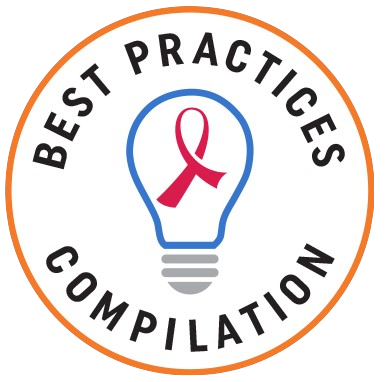The Test and Treat initiative, implemented by Oklahoma State University (OSU), connects people to antiretroviral therapy (ART) within 14 days of HIV diagnosis through streamlined intake and initial clinic visit protocols and 30-day medication starter packs. Participants in Test and Treat are linked to care and reach viral suppression sooner, and are more likely to be retained in care, as compared with people in standard care.
Tulsa, OK
Research shows that individuals who are linked to treatment immediately after HIV diagnosis are more likely to stay engaged in care and reach viral suppression. OSU clients were typically receiving their first ART prescription within weeks of diagnosis; Test and Treat aims to reduce that time.
OSU does not conduct testing onsite and therefore identifies people newly diagnosed with HIV through patient self-referrals and referrals from external organizations.
The same day OSU receives proof of HIV positivity, the intake, lab, and clinician visits are scheduled. The intake appointment is scheduled 30 minutes prior to the clinician visit and lab draw, all within a week of diagnosis. If the patient does not agree to the expedited Test and Treat protocol, a routine physician appointment will be scheduled in four weeks.
A patient services representative calls the client to talk through the initiation of the ART process and to indicate the information needed at the intake visit for enrollment into the Ryan White HIV/AIDS Program (RWHAP) Part B AIDS Drug Assistance Program (ADAP), which covers the cost of medications. Three days after diagnosis, adherence counseling is conducted with the patient and HIV positive status is verified with lab results. Patients are reassessed if they test negative for HIV and/or positive for tuberculosis.
During the clinical visit, the clinician obtains the lab values, administers the HIV Medication Readiness Scale, and provides a 30-day supply of ART. OSU established an agreement with the state ADAP for expedited eligibility to avoid gaps in care. Prior to this agreement, OSU relied on free samples from a pharmaceutical company.
A follow-up visit is scheduled with a clinician 24 days from the initial clinical visit for adherence counseling and lab review. Between clinical visits, there are multiple discussions with the client to promote adherence and reduce barriers to care, including visits and phone calls with a case manager, peer advocate, and therapist.
Data were collected on 44 individuals (22 in Test and Treat and 22 with the standard protocol) from August 2018 through February 2020. Measures included average days to clinician visit from diagnosis, average days to viral suppression from clinician visit, and retention in care. Individuals who participate in Test and Treat are linked to medical care and reach viral suppression much sooner and are retained in care at higher rates than those using OSU’s standard linkage protocol.
| Measure | Test and Treat | Standard Protocol |
|---|---|---|
| Time to first clinic visit | 5 days | 43 days |
| Time to viral suppression | 49 days | 95 days |
| Retained in care | 95% | 75% |
Source: Test & Treat in a Rural State. National Ryan White Conference on HIV Care & Treatment 2020 presentation.
- A champion within OSU, who performs all clinical visits for Test and Treat participants, developed the process flow and trained the front desk staff person and case manager.
- OSU established a relationship with a pharmaceutical company to receive free 30-day medication starter packs.
- OSU worked with the state ADAP to reduce the time to eligibility from 10–14 days to same day for Test and Treat clients.
- OSU established partnerships and marketed the effort with the Oklahoma State Department of Health (OSDH) and testing sites, including local health departments and AIDS service organizations. OSU also coordinates with the OSDH to receive HIV surveillance data on newly diagnosed individuals to ensure they are being linked to care. OSDH also provides rapid start services in rural areas to refer clients to OSU.
- The HIV Medication Readiness Scale was programmed as a “dot phrase” in Epic, the electronic health record system, to facilitate this assessment.
- The partnership with ADAP helps ensure continuous and immediate access to medication, a key component of Test and Treat.
- Another resource requirement of Test and Treat is staff time. OSU reports that staff need to spend a lot of time coordinating client care and communicating directly with clients to support them through the process. OSU recently received a RWHAP Part C Capacity Development Grant, which supports these staff, but is concerned about sustainability in the long term.
- Cancellations can lead to “same day” clinician visits. To schedule clinician appointments within a week, the OSU intake staff person often relies on cancellations, which lead to openings. However, if the clinician’s schedule is full, clients can see them on the one day a week when the clinician does not have clinic hours.
- Staff connection with clients is essential for active engagement. OSU attributes the positives outcomes of Test and Treat to the amount of time staff spend showing clients they care. During an initial phone call with the client immediately after diagnosis, the case manager gives clients "guiding hope" and informally assesses whether clients are ready for treatment. According to OSU, "Nine out of ten times, [the clients] are excited to access treatment."
- Clearly communicated steps and requirements support client success. OSU clearly describes the requirements and steps needed to access treatment, including ADAP enrollment.
"We do adherence counseling at every step in this process... and I think that is why Test and Treat works."
- Rapid Start Protocol
- Test and Treat presentation from the 2020 National Ryan White Conference on HIV Care and Treatment (see video below)

